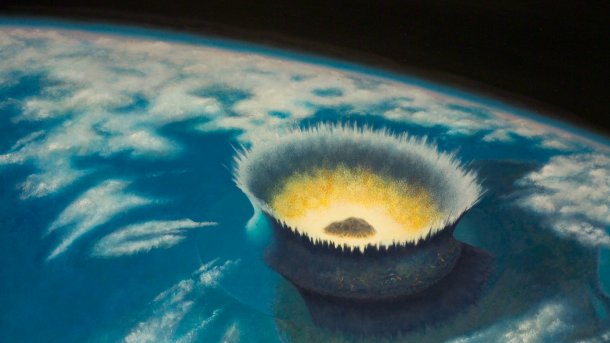Chicxulub impactor was probably an asteroid, not a comet
Based on ruthenium isotope data, a research team assumes that the dinosaurs did not die out due to a comet, but due to an asteroid.

Artistic representation of the impact
(Image: Dona Jalufka / Universität Wien)
The scientific debate about whether a comet or an asteroid hit the earth 66 million years ago and caused the extinction of the dinosaurs has taken another turn. According to an international team of scientists, they have found evidence that a carbonaceous asteroid struck near Chicxulub in what is now Mexico. To do so, they used a novel method that uses ruthenium isotopes to determine impact craters, according to an article in the journal Science (DOI: 10.1126/science.adk4868).
The team examined rocks from the crater formed by the impact. "The new ruthenium isotope data clearly show that the Chicxulub impact body was a carbonaceous asteroid that originally formed at a greater heliocentric distance beyond the orbit of Jupiter", Christian Köberl from the University of Vienna explains. They therefore do not support the assumption of a comet impact.
Carbonaceous chondrite
Previous chemical investigations using the platinum metal content and also the chromium isotope indicated a "carbonaceous chondrite", a very original and carbon-rich type of stony meteorite, the researchers explain. Recently, alternative explanations have been proposed, such as an impact by a comet.
Videos by heise
This theory was introduced into the debate a good three years ago by two US researchers. Using statistical analyses and simulations, they determined that a comet that was hurled from Jupiter towards the sun and torn apart there could have hit the Earth on its way back. This origin of the impactor could explain why it consisted of so-called carbonaceous chondrite, among other things. A comet could explain this "unusual composition".
In the current study, the research team discusses the geochemical composition of rocks in craters. Ruthenium is only found in very low concentrations in earth rocks; higher concentrations indicate a meteoritic composition. The team writes that the findings from the new research method are very promising for further work on identifying impacts and the composition of impactors on Earth.
(anw)